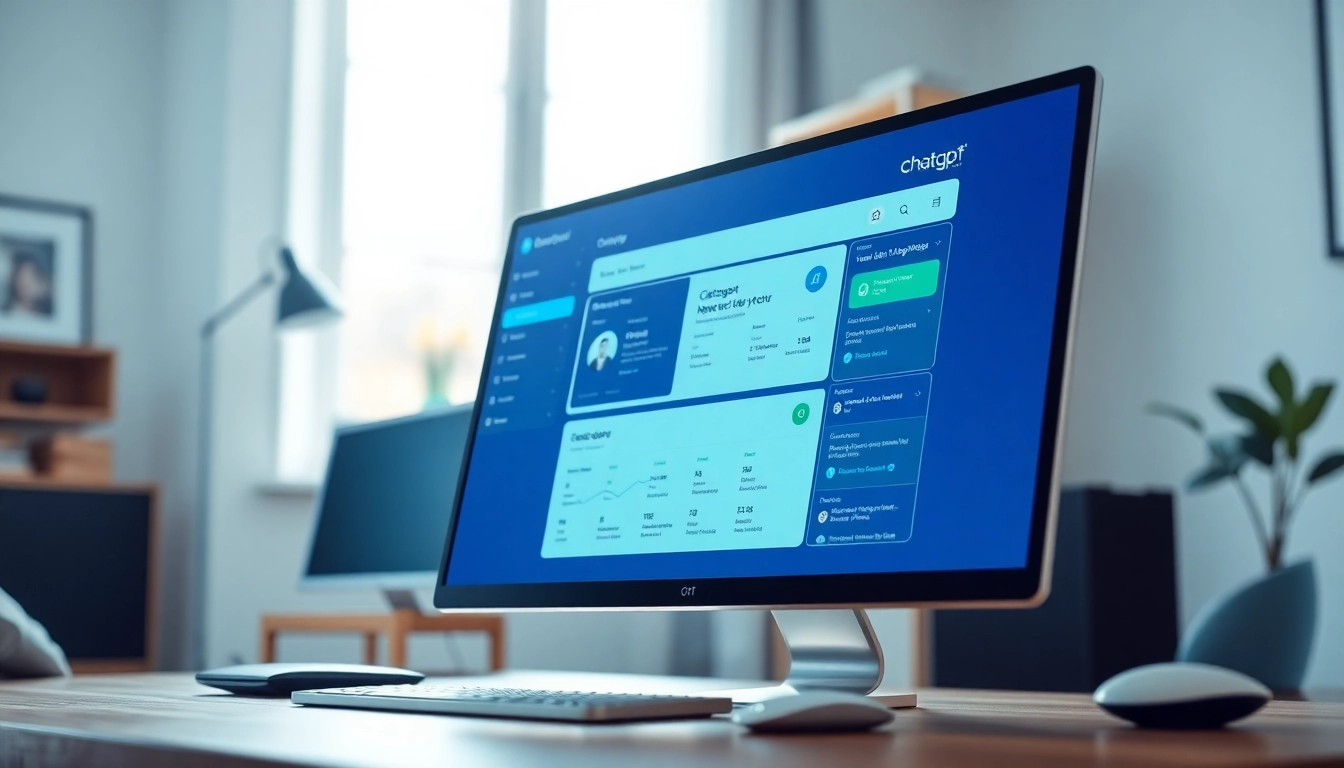Understanding the chatgpt Chatbot
What is a chatgpt Chatbot?
The chatgpt chatbot is an AI-driven conversational agent powered by the advanced natural language processing capabilities of OpenAI’s GPT models. These chatbots are designed to engage users in a dialogue that mimics human conversation, providing coherent and contextually aware responses. By leveraging vast amounts of data, chatgpt chatbots both understand user queries and generate replies that are informative, relevant, and personalized.
Unlike traditional chatbots that follow predetermined scripts, chatgpt chatbots utilize machine learning to understand nuances in language, enabling them to learn and adapt over time. This ability allows them to handle a wider array of topics and offer complex conversational threads, setting them apart in the realm of customer support, personal assistance, and content delivery.
Benefits of Implementing a chatgpt Chatbot
Incorporating a chatgpt chatbot into your business workflow provides several compelling advantages that can enhance customer interactions and support efficiency.
- 24/7 Availability: One of the most significant benefits is the ability to operate around the clock, allowing businesses to engage with customers at any time without the need for human agents.
- Cost Reduction: Automating customer interactions can lead to substantial cost savings, as it reduces the need for a large customer service team.
- Increased Scalability: chatgpt chatbots can handle a large volume of inquiries simultaneously, making it easier for businesses to scale their operations without compromising service quality.
- Personalization: Advanced algorithms allow chatgpt chatbots to remember user preferences, providing personalized responses that enhance user satisfaction.
- Data Collection and Analysis: These chatbots can gather and analyze user data, providing valuable insights that can inform business strategies and improve service offerings.
Common Use Cases for chatgpt Chatbots
The versatility of chatgpt chatbots makes them suitable for a wide range of applications across various industries. Here are some common use cases:
- Customer Support: Automating responses to common customer queries can significantly reduce wait times and improve user experience.
- E-commerce Assistance: Helping customers find products, providing recommendations, and facilitating purchases directly through conversation.
- Educational Tools: Assisting learners by providing information, answering questions, and guiding them through complex concepts.
- Healthcare Triage: Offering preliminary medical guidance or scheduling appointments, helping patients navigate healthcare services.
- Lead Generation: Engaging potential customers on websites to collect information and nurture leads for sales teams.
Integrating chatgpt Chatbots into Your Workflow
Assessing Your Needs for a chatgpt Chatbot
Before implementing a chatgpt chatbot, it’s crucial to assess your specific needs and objectives. Start by identifying the pain points in your current user interaction processes. Common considerations include:
- What are the most frequent queries or issues your users face?
- How many inquiries do you receive per day, and during which hours is traffic highest?
- What platforms do your customers use to engage with your services (website, social media, messaging apps)?
- What goals do you have for implementing the chatbot (e.g., increased engagement, reduced workload for human agents)?
Setting Up Your chatgpt Chatbot: Step-by-Step Guide
Integrating a chatgpt chatbot requires a thoughtful approach. Here’s a step-by-step guide to help you get started:
- Define Objectives: Clearly outline the primary goals for your chatbot, such as enhancing customer satisfaction or improving response time.
- Select the Right Platform: Choose a platform that supports integration with your existing systems and offers a user-friendly interface for customization.
- Train Your Chatbot: Input relevant data and frequently asked questions (FAQs) into the chatbot to enhance its knowledge base.
- Test and Iterate: Conduct thorough testing to ensure the chatbot understands user intent correctly and can resolve inquiries effectively.
- Launch and Monitor: Deploy the chatbot, monitor its performance, and gather user feedback to continuously refine its capabilities.
Best Practices for chatbot Configuration
To maximize the effectiveness of your chatgpt chatbot, consider these best practices:
- Clarity and Simplicity: Keep conversation flows straightforward. Avoid overly complex interactions that may confuse users.
- Context Awareness: Ensure the chatbot can remember context, allowing for seamless transitions in conversations.
- Fallback Options: Implement fallback responses to guide users toward human assistance when the bot cannot provide adequate information.
- Regular Updates and Maintenance: Continuously update the chatbot’s training data to reflect changes in products, services, or customer preferences.
- User-Centric Design: Create an engaging interface for the chatbot that reflects your brand’s voice and tone while being easy to use.
Enhancing User Experience with Your chatgpt Chatbot
Designing an Intuitive User Interface
The user interface (UI) plays a critical role in the usability of a chatgpt chatbot. An intuitive design allows users to interact effortlessly. Here are key design principles to consider:
- Easy Navigation: Organize interaction paths logically so that users can find information quickly.
- Prompting User Engagement: Use engaging prompts to encourage users to initiate conversation or learn more about specific features.
- Visual Elements: Incorporate images, buttons, and quick replies to enhance the conversational experience.
- Accessibility: Ensure that the chatbot is accessible to all users, including those with disabilities.
Improving User Engagement and Retention
High user engagement and retention are major indicators of a successful chatbot implementation. Strategies to bolster these include:
- Personalized Interactions: Leverage user data to personalize conversations based on prior interactions and preferences.
- Gamification: Introduce elements of gamification, such as rewards for returning users or achieving milestones.
- Regular Updates and New Features: Keep users intrigued by regularly introducing new functionalities and updates to the chatbot experience.
- Engaging Content Delivery: Provide valuable content through the chatbot, such as tips, articles, or product recommendations tailored to users’ needs.
Utilizing User Feedback for Continuous Improvement
Continuous improvement is integral to maintaining an effective chatgpt chatbot. It’s essential to actively solicit and incorporate user feedback:
- Post-Interaction Surveys: After resolving inquiries, ask users to provide feedback on their experience to identify areas of improvement.
- Monitor Interaction Metrics: Track metrics like conversation completion rates and user satisfaction scores to pinpoint weaknesses in bot interactions.
- Implement A/B Testing: Test different chatbot approaches to see which yields the best user satisfaction and engagement outcomes.
Performance Metrics for chatgpt Chatbots
Key Metrics to Measure chatbot Success
Evaluating the performance of your chatgpt chatbot is vital to understanding its effectiveness. Here are key metrics to keep track of:
- Response Accuracy: Measure how often the chatbot provides correct and relevant answers to user inquiries.
- User Satisfaction Score: Gauge satisfaction levels through surveys and user feedback after interactions.
- Engagement Rate: Analyze how often users interact with the chatbot and how long they remain engaged.
- Conversion Rates: For e-commerce chatbots, track conversions originating from interactions to evaluate sales effectiveness.
Analyzing User Data for Insights
User data analysis is a crucial component of chatbot performance refinement. Key strategies include:
- Segmenting Users: Divide users into segments based on behavior patterns, enabling targeted interactions that suit different needs.
- Identifying Common Friction Points: Look for frequent user complaints and refine the chatbot’s responses to address these issues better.
- Tracking Trends Over Time: Monitor how user interactions evolve to make informed adjustments to the chatbot’s knowledge base.
Adjusting Strategies Based on Performance
Adapting your chatbot strategies based on performance metrics is key to maintaining its relevance and effectiveness. Consider the following approaches:
- Regular Review Sessions: Schedule periodic assessments of chatbot performance to identify trends and areas for enhancement.
- Incorporate User Suggestions: Take user feedback seriously and implement changes based on the needs and challenges highlighted by actual users.
- Continuous Learning: Continuously feed new data into the chatbot to help it improve its conversation capabilities over time.
Future Trends in Chatbot Technology
Advancements in AI and chatgpt Capabilities
The chatbot landscape is evolving rapidly, with upcoming advancements expected to further enrich chatgpt capabilities. Trends driving this evolution include:
- Contextual Understanding: Future chatbots will likely possess even deeper context awareness, enabling more nuanced and human-like conversations.
- Emotion Recognition: Incorporating emotional intelligence, chatgpt chatbots may soon detect and respond to user emotions during interactions.
- Integration with IoT Devices: The ability to integrate with various Internet of Things (IoT) devices will expand chatbot functionality into diverse everyday contexts.
Emerging Use Cases for chatgpt Chatbots
As technology advances, new use cases for chatgpt chatbots will emerge. Some anticipated applications include:
- Advanced Financial Assistance: Providing tailored financial advice and customer support for fintech companies based on user data.
- Virtual Travel Assistants: Offering real-time travel recommendations, itinerary management, and customer service for travelers.
- Smart Personal Assistants: Pervasively embedded in devices, these chatbots could handle daily tasks and improve productivity through seamless interaction.
Preparing for the Future of Customer Interaction
Businesses must strategize for the future of customer interaction with chatgpt chatbots. This includes:
- Investing in Training and Development: Equip teams with the knowledge to leverage chatbot technologies effectively and adapt to future innovations.
- Fostering Collaboration: Encourage collaboration between chatbot designers, customer service teams, and AI specialists to create holistic user experiences.
- Staying Informed: Keep abreast of the latest developments in AI and chatbot technology to remain competitive in the marketplace.



